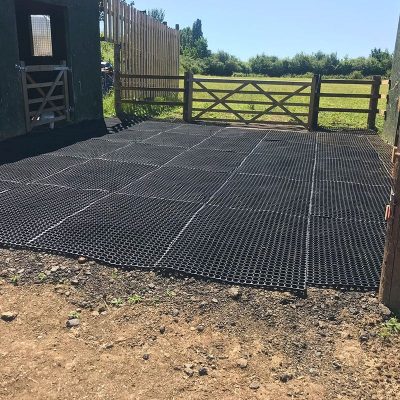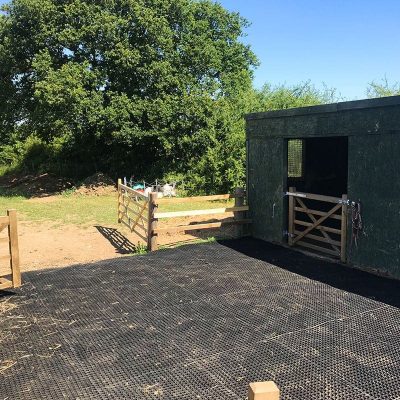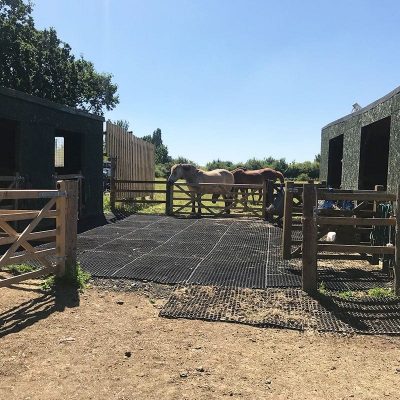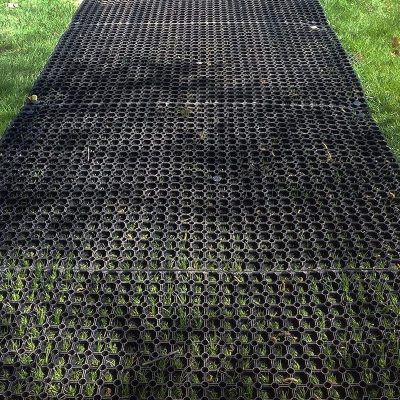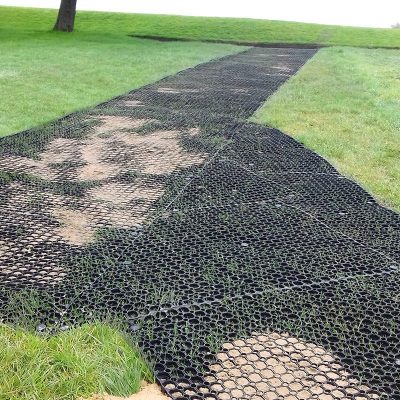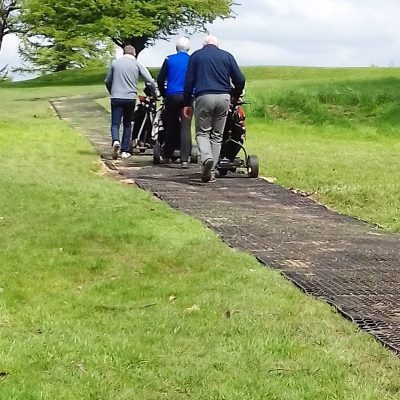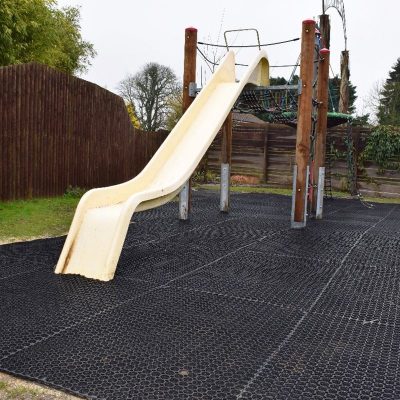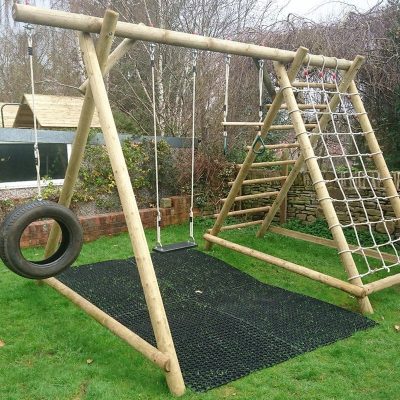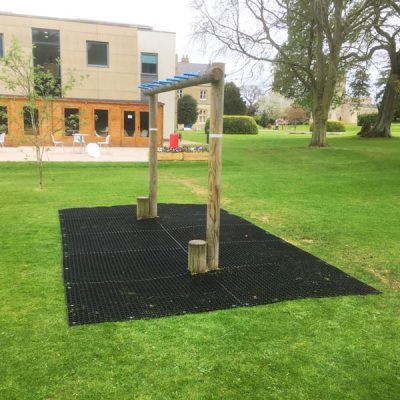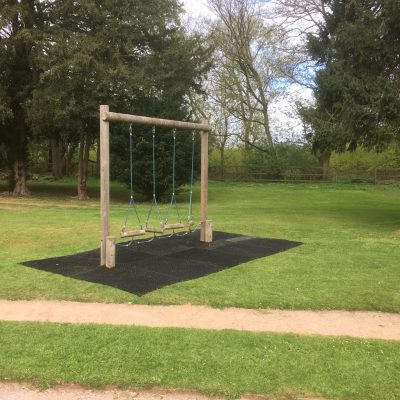Rubber Grass Mats
Protection • Safety • Playground • Equestrian
Rubber Grass Protection Mats
Manufactured from flexible, highly durable rubber, rubber mats are designed for use both indoors and outside for a vast range of applications.
Each grass mat measures 1.5m² (100x150cm) and is secured to the ground with the use of an appropriate plastic peg.
When used for playgrounds and underneath play equipment the 23mm rubber mats can offer critical fall protection for a height of up to 3.3m.
These mats can be used for grass protection and help to prevent grass root and soil erosion in areas with high footfall and will allow grass blades to grow and flourish
Rubber equestrian mats
The equestrian market is a sector in which rubber grass mats can make a marked difference and provide solutions to many varied issues.
With many stables and farms having unfinished surfaces such as gravel, hardcore or dirt the areas surrounding the stables can become difficult to traverse and can also have an adverse effect on horse hooves.
By utilising the rubber grass mats for yards, common walking areas, around access points such as gates and stiles, the integrity of the surface can be improved.
As the mats are non-slip, they can provide an extra level of safety around farms and stables to prevent slips and falls for both humans and animals alike.
Grass mats for golf courses
The emphasis of year-round accessibility and protection of a grassed surface is paramount for golf courses.
The reputation of any golf course can be irreparably damaged by poor drainage and neglect of high traffic areas such as tees, paths and buggy tracks.
When these areas become bare and muddy, golf courses may need to close or restrict access to certain holes, impacting on revenue.
Rubber grass mats are a simple and versatile choice for golf courses as the rubber mat can be laid directly onto a grass surface and it will begin to protect that grassed area immediately.
Useful for around teeboxes, bunkers and along pathways alongside fairways or any highly trafficked area, rubber mats are an inexpensive and effective solution.
rubber mats for camping
Rubber grass mats can be used to create a reinforced surface for camping. Often, during periods of inclement weather grass can become saturated and unsuitable for camping on.
Campsites can use our rubber mats to create durable grass pitches for tents, motorhomes, caravans and awnings. By doing so, the quality of the surface will be improved and the cleanliness due to reduction of mud around the site will be noticeable, all year round.
As mats are simply pegged into place, they can be laid to create walkways and paths around camp sites temporarily during autumn and winter and removed and stored in spring and summer.
Grass mats for Schools
The rubber mats are highly popular with schools and other education establishments as there is a large concentration of children and often with a number of pieces of play apparatus.
Mats can be used around low-level play apparatus such as trim-trails but also for larger pieces such as full climbing frames and swings.
Once installed, grass can mature through the holes and will help to disguise the grass mats and produce a lush, green, safe surface for exercise and play.
The rubber playground mats can be used to also help reduce mud around school when used alongside paths to fortify the ground and help to protect from grass and soil erosion by pedestrians.
anti fatigue matting
Due to the soft nature of rubber grass mats, they can be used in an industrial setting where operatives are standing on hard and cold surfaces for prolonged periods, which helps to reduce the amount of stress on bones, joints and ligaments.
Due to the texture of the surface of the mat, operatives standing on the mat will move around, improving circulation and reducing tiredness of limbs.
This can result in health benefits such as relieving tension, supporting muscles, reducing joint stiffness, back pain and foot fatigue. These health benefits can translate into increased productivity, reduction in sick days and boost employee morale.
Rubber boat matting
Non-slip surfacing is a highly important factor in boating and marine applications due to the presence of large volumes of water and the need for stability underfoot to reduce the risk of falling overboard.
With the presence of salt in seawater and the harsh weather conditions at both ends of the scale, it’s vital that the materials used can withstand some tough treatment.
Rubber grass mats are an outstanding solution for creating a non-slip surface on boats, yachts, oil rigs and other marine applications such as jetties, pontoons and slipways.
The rubber mats simply cable tie to each other and then form a single surface which should require very little additional fixing, if any at all and can be cut to match practically any shape.
Should decks require cleaning or painting, the mats can simply be rolled up or lifted and removed during the work and replaced once completed.
Rubber playground mats
Rubber ring mats are perfect for use in playgrounds and beneath play equipment and in parks.
With a critical fall height (CFH) rating of up to 3.3m and compliance with BS EN:1176, rubber grass mats can mean the difference between serious injury and slight bump.
As the grass mats strengthen and fortify the grass surface, the amount of soil erosion is reduced and the quality and density of the grass is improved.
The mats can simply be laid onto closely mown grass and pegged into place, providing immediate protection against falls, trips and other accidents.
For an integrated installation, the top layer of turf can be removed and the surface re-seeded to encourage new grass growth with the mats in place.
Knowledge Base
Rubber Grass Mat Installation
1. Measure and mark out the site where the rubber grass mats will be installed, cut the grass short, remove all clippings and debris.
2. Level out uneven areas using a good quality sandy topsoil. Firm the surface and seed or turf the area.
3. On sites where the grass surface is prone to becoming wet and soft, the installation of an additional layer of lightweight plastic GrassMesh450 can be used to provide additional structural support to the rubber grass mats. GrassMesh450 should be secured with U-Pins around the perimeter at 50cm intervals.
4. Lay out the rubber grass mats on the proposed area and cut the mats to fit around any play equipment or obstacles as
required.
5. Proceed around the area from one perimeter edge butting the rubber grass mats firmly against each other. Using cable ties at 150mm intervals, fasten all edges tightly together. Trim off the ends of the fixed cable ties ensuring that the cut end of the ties are not creating a hazard by being exposed above the surface of the rubber grass mats.
6. Whilst fixing the cable ties to the edges of the rubber grass mats, secure down using the plastic fixing pegs at intervals of 500mm.
OPTIONAL EDGE BLENDING WHERE A DISCREET GRASS TO RUBBER INTERFACE IS REQUIRED
7. Using a spade or half-moon edging tool, cut a slit into the ground along the perimeter edge of the rubber grass mats and
to a depth of approximately 75mm.
8. Roll back the edge of the rubber grass mats. Using a spade and starting approximately 150mm from the slit and working away from the rolled back mat, cut a wedged shaped slice of turf (retaining wedge where needed) leaving a wedge
shaped exposed soil channel. Continue this operation around the perimeter of the rubber grass mats where edge blending is required.
9. Roll the edge of the rubber grass mats back down into the exposed wedge shaped channel. Pin the edge to the ground through the small holes in the mat with plastic fixing pegs at intervals of 500mm.
10. Refill the exposed ramped edge to its original ground level with topsoil, then trim a layer of soil from the retained turf to give it an appropriate thickness (approx 50mm), then re-bed the turf over the filled rubber grass mats and firm it into
place to provide a discreet edge.
11. The grass will grow through and cover the apertures of the rubber grass mats within 4-6 weeks. Grass can be mown as normal.
Contact
Us
